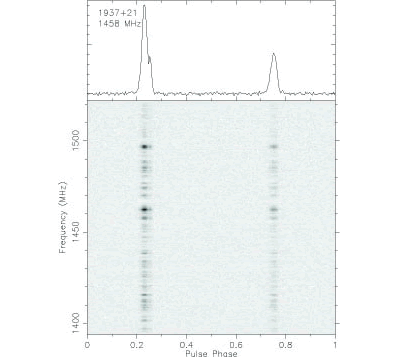
On February 18, the first Expanded Very Large Array (EVLA) pulsar detection was accomplished by processing phased array voltage data with coherent de-dispersion software. This observation is a successful proof-of-concept for the use of the EVLA as a pulsar-timing instrument.
High-precision timing of millisecond pulsars has a number of scientific applications, including tests of gravity, exploring nuclear physics via neutron star mass measurements, and direct detection of ultra-low frequency gravitational waves (see NANOGrav). These studies have traditionally been carried out using large single-dish telescopes. However, the excellent point source sensitivity and octave-bandwidth receivers of the EVLA promise to make it a world-class pulsar-timing instrument as well.
This observation builds on recent efforts to operate the EVLA in phased array mode for very long baseline interferometry (VLBI). In this mode, the array effectively acts as a single large dish, providing a single beam of voltage data similar to the output of a single-dish telescope. For VLBI, the raw data are recorded directly to disk for eventual correlation with other station data. For pulsar timing, a coherent de-dispersion filter is first applied to the data, then they are detected and averaged modulo the pulse period. Coherent de-dispersion must be done pre-detection, and is required to exactly remove the dispersive effects of the interstellar medium from the pulsar signal and achieve the best possible timing results.
See the website for more details.
http://science.nrao.edu/enews/4.3/#almaconstructionprogress(SY)

